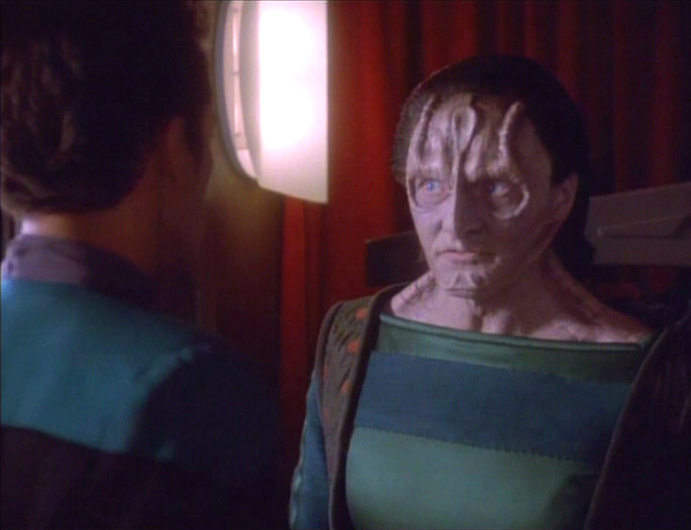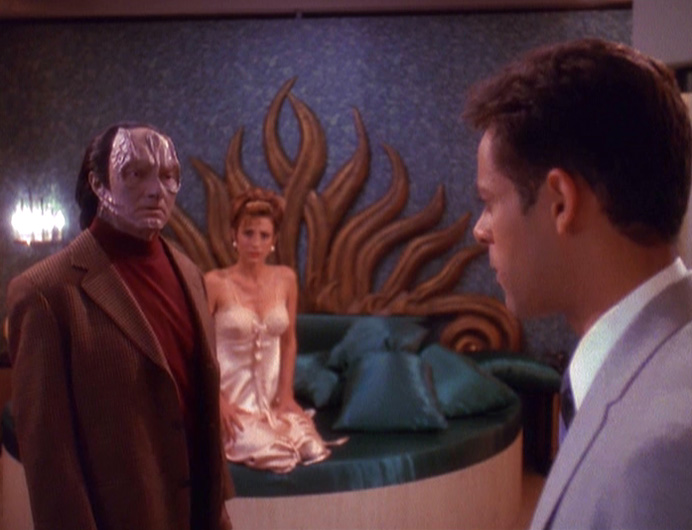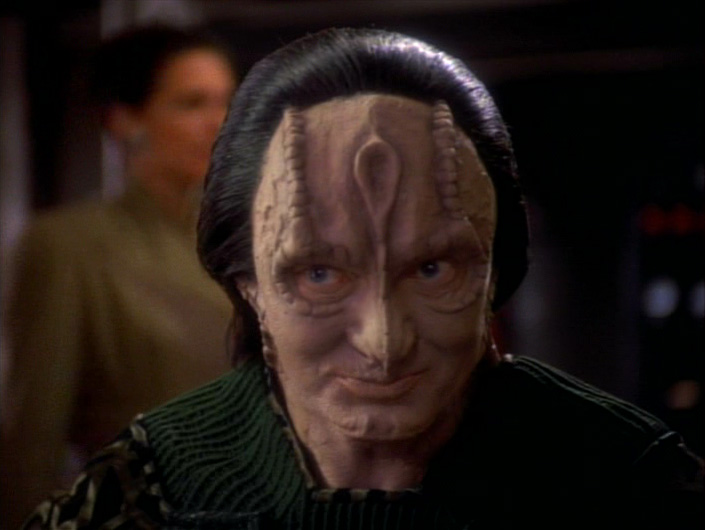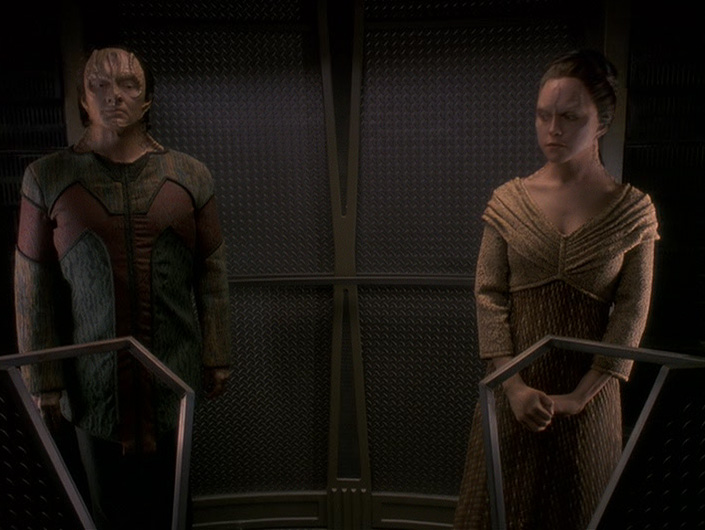 Star Trek has often been ground breaking, whether that meant having an ethnically diverse cast, promoting peaceful protest, advocating birth control, or discussing many other taboo subjects. Yet one area where Trek noticeably lagged behind for decades was in its depiction of LGBTQIAP+ characters. While members of The Next Generation cast advocated for a character to be part of the community, Deep Space Nine had for a brief time a character, Elim Garak, Cardassian spy turned tailor, whom the actor, Andrew Robinson, purposefully played as sexually attracted to Dr. Bashir. Unfortunately, instead of the writers embracing this facet of the character to explore sexuality in the Federation and the Cardassian Empire, an awkward and rather uncomfortable heterosexual relationship was created for him out of left field with the much younger Tora Ziyal. The writers of DS9 were so determined to keep one of their main supporting characters heterosexual that they ended up wasting excellent plotlines and character growth to stay in the “norm,” while also creating a relationship that felt rushed and very questionable.
Star Trek has often been ground breaking, whether that meant having an ethnically diverse cast, promoting peaceful protest, advocating birth control, or discussing many other taboo subjects. Yet one area where Trek noticeably lagged behind for decades was in its depiction of LGBTQIAP+ characters. While members of The Next Generation cast advocated for a character to be part of the community, Deep Space Nine had for a brief time a character, Elim Garak, Cardassian spy turned tailor, whom the actor, Andrew Robinson, purposefully played as sexually attracted to Dr. Bashir. Unfortunately, instead of the writers embracing this facet of the character to explore sexuality in the Federation and the Cardassian Empire, an awkward and rather uncomfortable heterosexual relationship was created for him out of left field with the much younger Tora Ziyal. The writers of DS9 were so determined to keep one of their main supporting characters heterosexual that they ended up wasting excellent plotlines and character growth to stay in the “norm,” while also creating a relationship that felt rushed and very questionable.
While DS9 did have the first kiss between two women in Trek history, it was framed around the characters who shared the kiss being part of the Trill, an alien species where worm-like beings could be transferred from one host humanoid Trill to another, regardless of gender. The relationship between the two characters was therefore explained by their being heterosexual lovers in their former lives, and it ended with one episode because of the Trill’s taboo against “reassociation.”

However, since Garak was, as far as the show implied, a cisgendered Cardassian male, his interactions with implied cisgendered human male Doctor Julian Bashir, were stifled. While both continue to have meals together with plenty of dialog that would not be out of place between some of the heterosexual couples on DS9, Dr. Bashir’s feelings toward Jadzia Dax are constantly referenced, as though to pull a Wizard of Oz curtain over the less than platonic “cultural exchange” between Garak and Bashir. The two often playfully bicker in the style of an old married couple with different tastes, such as Bashir complaining about the repetitive narrative of Cardassian literature, with Garak retorting that Shakespeare is not to his taste either.
The clear parallels to a romantic relationship are amplified during their time in Bashir’s malfunctioning holonovel that’s a barely veiled James Bond pastiche. Garak emotes in a way all too familiar to a spouse being dragged along with their partner’s hobbies that they don’t understand or enjoy. While Bashir often bickered in a similar style with O’Brien, Garak usually injected an edge of flirtatious teasing, often commenting to the effect that he will pull the wool off of Bashir’s eyes, showing the doctor the deep and dark underside to the “Outer Frontier” Bashir was so excited to explore.

Garak also revealed personal details to Bashir that he didn’t divulge to others. Some of these details could have compromised his life on DS9 as they challenged his claim to be “plain, simple Garak,” a mere tailor. Garak only seems to feel comfortable divulging personal details to Bashir. “The Wire” is a prime example of how much Garak is willing to reveal to Bashir. As the cranial implant that was meant to help him withstand torture overloads, due to Garak using its endorphin releases to make his life on the station more bearable, he tells three different stories with one central common thread: his actions led to his friend Elim being killed. While all three stories are very different, all reveal Garak still feels guilty about causing his friend’s death and how his punishment was being banished to the station, never to return to Cardassia. Later in the episode the truth is revealed by Enabran Tain, former head of the Obsidian Order, Cardassia’s spy network. Garak is Elim—all three stories he told Bashir are lies, except for the fact that he was exiled to the station. At first glance this series of lies may suggest that Garak doesn’t trust Bashir, but Garak revealed his first name and has dedicated himself to showing Bashir the dark side of life on the station, the political and social tensions that may change their lives in an instant. He even quips as much when Bashir asks him about this at the end of the episode:
Bashir: “Of all the stories you told me, which ones were true and which ones weren’t?”
Garak: “My dear Doctor, they’re all true.”
Bashir: “Even the lies?”
Garak: “Especially the lies.”

However, the hinted at relationship between the two is cut off by the arrival of Tora Ziyal, the half-Bajoran, half-Cardassian daughter of the series long antagonist, Gul Dukat. Although she is the one who falls for Garak, he ends up reciprocating her feelings. Several factors make this relationship awkward. Garak and Dukat were rivals during the Cardassian Occupation of Bajor and Garak often opposed Dukat while the former was part of the Obsidian Order. Their relationship also has a hint of “falling for the only other person like me,” as they are the only two Cardassians on DS9 who are not related. Although neither of Dukat or Garak’s ages are revealed, they are clearly meant to be close in age, which makes the relationship between Ziyal and Garak very awkward as she is clearly decades younger than Garak. In fact, Ziyal’s birthdate puts her at eighteen, and the first two actresses who played her come across as younger than that,which makes it even more unsettling (and the first actress to portray Ziyal was thirty years younger than Andrew Robinson!). While Bashir is meant to be a twenty-something when he and Garak first met, they have spent years learning about each other and becoming friends, whereas Ziyal and Garak seem to have a whirlwind romance, falling for each other very quickly. It is also important to note the differences in social position between Bashir and Ziyal – he has a successful Starfleet career and is up for a prestigious award in his twenties plus has a social life outside of his relationship with Garak, whereas Ziyal has been an outcast from birth due to her parentage and having lived in a labor camp until Kira rescues her, leaving Ziyal more emotionally vulnerable than Bashir since Kira is her only real friend on the station. Did her interest in Garak come from her drive to find someone to be close to? Ziyal and Garak may have both been better served if they had become student and teacher, paralleling her relationship with Kira and allowing Ziyal to embrace both sides of her heritage.
It would take until the TOS Reboot movies for LGBTQIAP+ relationships to be recognized in Trek canon, even though various cast members from TNG onwards had advocated for more queer diversity in the series. On DS9, Andrew Robinson’s Garak originally started out as a clearly non-heterosexual character who was developing a relationship with Doctor Julian Bashir. Yet the writers forced a heterosexual relationship between Garak and Ziyal, even with the huge age gap between the characters, and speeding up the development of the relationship, compared to the slowly evolving relationship between Garak and Bashir. Although the series writers never let the Garak and Bashir relationship evolve beyond friendship, fans have embraced Garak as a queer character and have explored this in fandom.